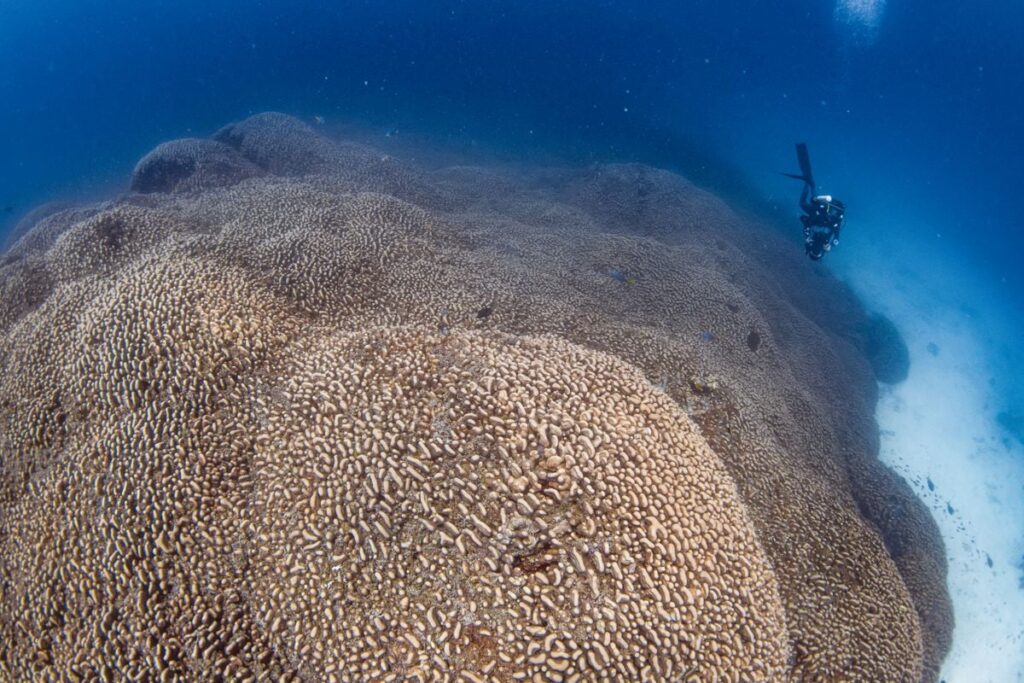A diver swims alongside the world’s largest coral colony, located in the Solomon Islands.
Manu San Félix / National Geographic Pristine Seas
Researchers have made a gargantuan discovery that’s as large as two basketball courts, visible from space, at least 300 years old and brimming with marine life: It’s the world’s largest coral, found in the southwest Pacific Ocean.
Scientists and filmmakers spotted the massive coral in the Solomon Islands in October and announced the news this week. They had been filming near the island of Malaulalo for National Geographic’s Pristine Seas project, which aims to promote the creation of new marine protected areas. The team was working in partnership with the government of the Solomon Islands.
Coral reefs are made up of many different, genetically distinct coral colonies. But the recently discovered organism is its own unique colony, consisting of millions of individual animals, called polyps, that are genetically identical. The polyps belong to a species called Pavona clavus.
The newly identified coral is mostly made up of knobby protrusions in a drab brown color—but it also has more vibrant areas of blues, reds and yellows. Scientists spotted fish, crabs, shrimp and other marine creatures using the coral for shelter and breeding.
At about 112 feet wide, 105 feet long and 18 feet tall, the coral is enormous. It’s so big that scientists initially thought it was a shipwreck. They also had to measure the organism in stages, because their underwater measuring tapes were not long enough to capture its colossal size in one go.
The coral is longer than a blue whale, the largest animal on the planet. It’s “close to the size of a cathedral,” says Manu San Félix, an underwater cinematographer and marine biologist who first spotted the coral, to CNN’s Laura Paddison.
Measuring the sprawling coral proved tricky.
Manu San Félix / National Geographic Pristine Seas
The as-yet-unnamed coral takes the crown from the previous record-holder, an organism in American Samoa affectionately known as “Big Momma” that’s around 21 feet tall.
Based on its gargantuan size, researchers say the newly discovered coral is likely between 300 and 500 years old.
“When Napoleon was alive, this thing was here,” San Félix tells Vox’s Benji Jones.
At first, the team thought the brown blob they spotted underwater might be a shipwreck.
Manu San Félix / National Geographic Pristine Seas
The coral’s discovery was welcome news to the leaders of the Solomon Islands, who say this new claim to fame could help boost conservation efforts and funding, as well as attract the attention of tourists and scientists.
“We want the world to know that this is a special place and it needs to be protected,” says Trevor Manemahaga, the Solomon Islands’ minister of environment, to BBC News’ Georgina Rannard.
But, although it may be located in a remote, hard-to-reach part of the world, the coral is “not safe from global warming and other human threats,” says Enric Sala, a National Geographic explorer in residence and founder of the Pristine Seas initiative, in a statement.
The coral is so big it can be seen from space.
Steve Spence / National Geographic Pristine Seas
The sprawling coral’s discovery was officially announced one day after the International Union for Conservation of Nature revealed that 44 percent of the 892 known species of warm-water, reef-building coral are at risk of extinction. Coral face myriad threats, including rising ocean temperatures caused by climate change, overfishing, pollution and diseases.
“We’ve known for decades that coral reefs are on the frontline of the global climate and biodiversity crises, and this new result only reconfirms this,” says David Obura, a marine ecologist who co-chairs the IUCN’s coral specialist group, in a statement. “Without relevant decisions from those with the power to change this trajectory, we will see the further loss of reefs, and progressive disappearance of coral species at larger and larger scales.”
Still, the finding of this huge coral in the so-called “Coral Triangle” is reason for optimism. Its size and longevity suggest that some corals may be resilient to threats and adaptable to changes in their environment.
“The existence of large and old corals is a sign of hope—that it’s not too late to protect, conserve and restore the oceans while fighting against climate change,” says David M. Baker, a marine scientist at the University of Hong Kong, to NBC News’ Peter Guo.


